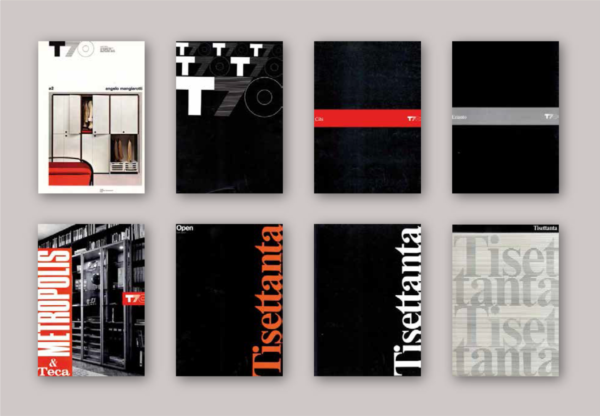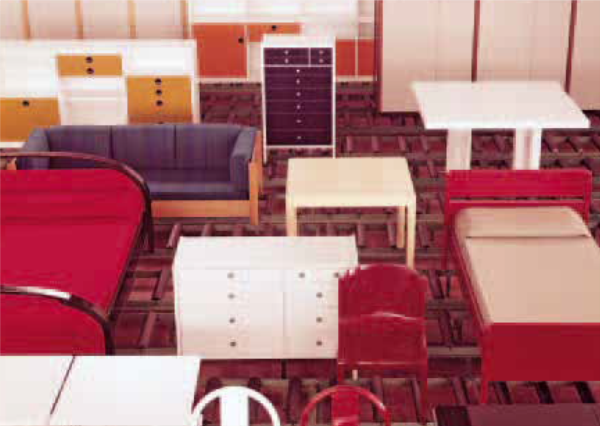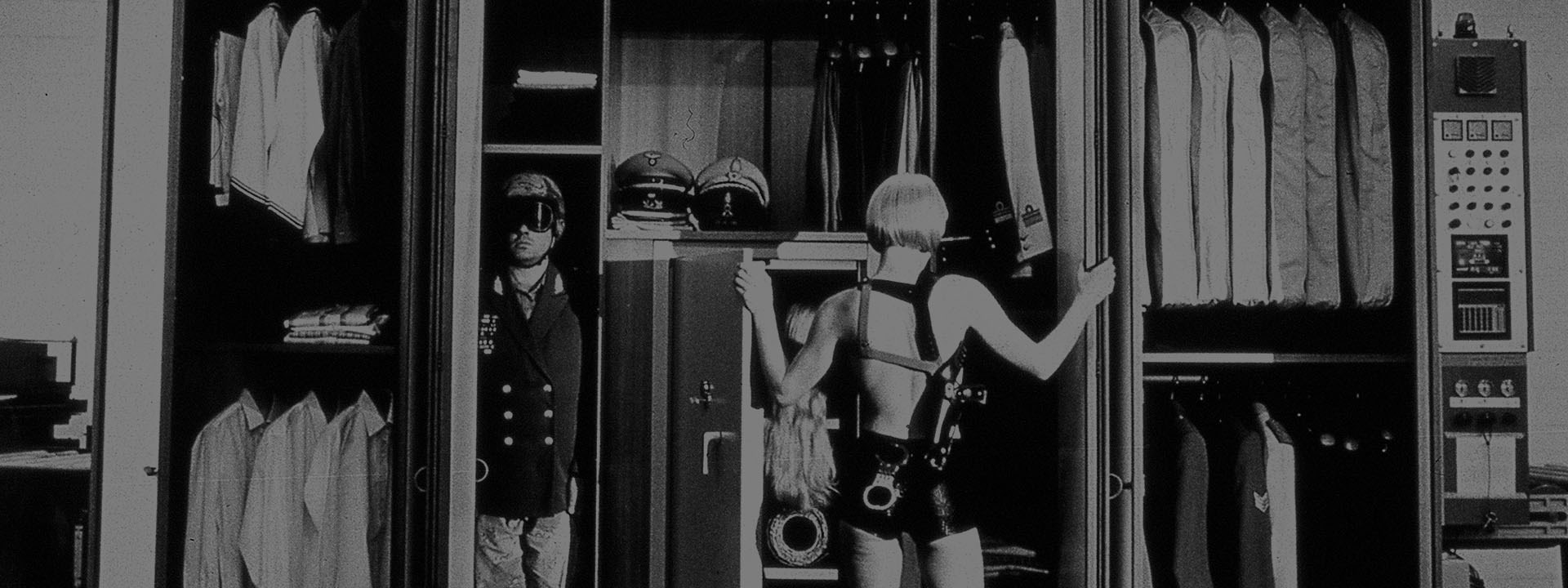History
Company profile
To write about Tisettanta without mentioning those who built the company with their graphics and photography would be an unforgivable oversight.

To write about Tisettanta without mentioning those who built the company with their graphics and photography would be an unforgivable oversight.
Many are the people who, through their professional experience, left their own special mark on the company, and added value to a product that was already clearly identifiable on its own.
Many are the people who, through their professional experience, left their own special mark on the company, and added value to a product that was already clearly identifiable on its own.
1969 TAVOLO MITO
Carlo Bartoli

Bartoli, who had already designed several products for Arflex, set down to work and made the first two products—his Mito chair and table (1969)—which were really the archetypes of the new productive image,

1969 SISTEMA MULTIPLO
Carlo Bartoli

In 1968 Fratelli Turati Snc was busy manufacturing its products in the company’s historical site on Via Garibaldi in Giussano, and the first new models came right out of this plant. The first two years can be described as frenetic and amazingly creative; a large number of innovative creations saw the light: in those years they rose up to the role of status products and would be distinguished for their unmistakable Italian style and taste.

1968 ARMADIO A1
Angelo Magiarotti
At the same time Bartoli, who was determined to create an ambitious project, called to his side some architects who today represent the crème de la crème of Italian design and architecture, names like Gae Aulenti, Angelo Mangiarotti, Annig Sarian, Vico Magistretti, together with Motomi Kawakami from Japan, a young collaborator in Mangiarotti’s studio at the time.

1968 LETTO ALISSO
Annig Sarian
1969 SISTEMA MULTIPLO
Carlo Bartoli

Thanks to this technology, the systems that we now commonly identify as storage units— also known as bussolotti—took shape; Multiplo (1969) and Eco (1969) were among the first products to be manufactured this way. The new industrial techniques thus allowed us to respond to the Italian market’s huge demand for products, and Multiplo’s success was outstanding


1965 SEDIA THALIA
Annig Sarian
1969 DIVANO SILOE
Vico Magistretti

In 1968 Fratelli Turati Snc was busy manufacturing its products in the company’s historical site on Via Garibaldi in Giussano, and the first new models came right out of this plant. The first two years can be described as frenetic and amazingly creative; a large number of innovative creations saw the light: in those years they rose up to the role of status products and would be distinguished for their unmistakable Italian style and taste.

1967 SEDIA SM400K
Gerd Lange
The '70s
1975 TAVOLO NODO
Carlo Bartoli

In the meantime, Carlo Bartoli had in fact taken on the role that today we would define as the art director of Tisettanta.
He personally designed many new products such as the 920C-1971 armchair, the highly successful Nodo table
(1970)
He personally designed many new products such as the 920C-1971 armchair, the highly successful Nodo table
(1970)

1971 TAVOLINO SERVICE
Carlo Bartoli

He personally designed many of the new products, for instance the 920C chair (1971), the very successful Nodo table (1970), the Sofà bed (1971), the Service multiuse table (1971), the Clear modular bookcases (1973), which ideally could have been a cash-and-carry sort of product akin to what Ikea sells, if it hadn’t been for the fact that they were made in Italy and a few decades too early; the same can be said for the Altobasso living room table (1976), that could be raised up and expanded for eating, the Midi and Loto tables (both from 1977), and the Big shelves (1977).
1970 SISTEMA ECO
Gae Aulenti

At the same time, Bartoli continued to work even more closely with his friend Sarian, who developed new products for Tisettanta such as the Dixie bed, and introduced the Nodo chair (1975), invented by Mauro Pasquinelli, into the company’s collection: this particular object would be selected for the 1979 Compasso d’Oro awards, and in 1981 it would be displayed at Ljubljana’s design biennale BIO. Bartoli also added to the catalogue the SM400K chair (1967), made exclusively for Italy by Gerd Lange, and designed for the German company Drabert, Ferdi Baleri’s Scacco furniture unit-wall-partition, as well as a number of products designed by Antonello Mosca, such as his Theo and Clivio beds with matching commode and night tables, t135, a table with a cocktail cabinet, as well as c103, a chest of drawers.

1975 CASSETTIERE C103 ⁄ CLIVIO
Antonello Mosca

1972 ARMADIO POLIEDRO
Tisettanta C.R.S.

1979 SEDIA ZEA
Annig Sarian
1979 SISTEMA ERIANTO
Annig Sarian

In 1979 Annig Sarian succeeded Carlo Bartoli as art director, thus guaranteeing continuity. Nonetheless, Bartoli, who had been working for the company for years if not decades, continued to bring Turati many new ideas. These led to the company’s Open (1978), Circus (1979), Cibi (1982), C&C (1983), Mix (1987) furniture systems, the Sado table (1979), and the expandable table called Thesi (1979).

1971: first collection
Carlo Bartoli design
To complete this vast range of furnishings, Tisettanta also began to manufacture combination and modular cabinet systems, thus making the best use of its machinery also for the system referred to as having bookcases.
The '80s
1980 LETTO ARIANNE
Annig Sarian

In the meantime, Carlo Bartoli had in fact assumed the role of today we would define as the artistic director of Tisettanta.
He personally designed many new products such as the 920C-1971 armchair, the highly successful Nodo table (1970).
He personally designed many new products such as the 920C-1971 armchair, the highly successful Nodo table (1970).

1985 SISTEMA METROPOLIS
Antonio Citterio

Citterio continues: “the collaboration began in 1984. They called me. Nineteen eighty-four was the year I started getting lots of work. I had closed down my previous studio, with Paolo Nava, in 1982, so those were years I was starting up new activities. I remember meeting the Turatis because they wanted to do something brand new; Tisettanta was in the midst of a period of strong economic development and they wanted to start a project that would eventually become Metropolis.

1985 SEDIA CARLINA
Annig Sarian
1986 TAVOLO MISSOURI
Michele De Lucchi

Michele De Lucchi recalls that “I went to the company premises once or twice; these short meetings were a way of getting all the information on the project that I was being commissioned to make by Tisettanta. I once had a wonderful conversation with Peppino Turati, which made me think about the company’s success.

1988 ARMADIO CENTER
Antonio Citterio
1988 LIBRERIA ACHILLE
Vittorio Prato

Vittorio Prato created the Achille bookcase and the Filippo table, Julia Binfield the Portofino mirror, and Mirto Zocca the Mirto desk.

1988 COMPLEMENTI ARTURO
Enrico Franzolini
Citterio was joined by Enrico Franzolini who signed the Ginevra armchair and the group of accessories of the Arturo family, again Michele De Lucchi with the Michele table, while Vittorio Prato created the Achille bookcase and the Filippo table, Julia Binfield the Portofino mirror, and Mirto Zocca the Mirto desk.
The '90
1994 SISTEMA QUADRATUS
Antonio Citterio

Three years later it was Quadratus (1994) that got all the honors at the Furniture Fair. Citterio had developed it to replace Annig Sarian’s Erianto that, after a worthy 15-year-long career, was beginning to show some weakness before the competition’s newer and more aggressive products. The new system featured horizontal elements, such as benches, thick tops and shelves, which framed and heightened the traditional box shapes.


1996 ARMADIO XELLE
Antonio Citterio

1998 SISTEMA CENTOPERCENTO
Antonio Citterio

The second step was to present in February of the same year, exclusively for its clients, and then at the Furniture Fair in April, the new and elegant collection of Centopercento closets, 1998, and the Centopercento cabina armadio system (1998), both signed by Citterio. Featuring rich finishings and wooden and aluminum clothes hangers, the cabin especially made its mark for the very innovative and original way—which remained almost completely invisible— that the accessories were hung, at the same time allowing for the total flexibility of the parts and their simple repositioning without requiring the help of specialized staff.

1999 SISTEMA QUADRATUS 99
Antonio Citterio
1999 LETTO NIKKA
Marco Boga

Between 1995 and 2004, collaboration with the architect Marco Boga was important. Many products were born for Halifax: the Venice mirrors (1993; in collaboration with Ricardo Cassina), Milan (1996), Riflessi (1997), Tokyo (1999), Imago (1999), the Dedalo beds (1996), Petaso (1997 ), Nikka (1999), Charlotte (2004).
The '00s
2004 SISTEMA METROPOLIS 2004
Tisettanta Design Lab


2005 SISTEMA CENTOPERCENTO 2005
Tisettanta Design Lab
the renewed Mixel collection was presented, signed by the Tisettanta-Design-Lab, that is, the in-house restructured research center led by Ambrogio Spotti, flanked by the engineering office, in turn supervised by Gianni Gatti.
2004 POLTRONA BUBBLE
Marco Boga


2008 SISTEMA THESIS
Tisettanta Design Lab


2009 LETTO TAFFY
Ennio Arosio
Also in that year, two bedroom sets for the bedroom designed by Ennio Arosio were presented at the Salone del Mobile: Taffy (2009) and Pyllon (2009). This brief historical excursus ends, provisionally, with the year 2010, when in Tisettanta we realized the approach of the important fortieth anniversary.
2009 SISTEMA ACROPOLIS
Piva Associati

In the second half of that year, relations were re-established with Paolo Piva, who was entrusted with the task of creating various products to be introduced into Halifax such as the Medusa chair (2009), the Amelie armchair (2009), the Onda seating system (2009 ) and the pouf Point (2009).

2009 SISTEMA ACROPOLIS
Piva Associati
Elam: not just Zanuso’s E5
1964 CUCINA E5
Marco Zanuso

Elam was born out of the same crucible of creative renewal that put the Brianza area companies in the international spotlight starting in the 1960s. Indeed the meeting between Marco Zanuso and Elam took place in that very decade and it led to the birth of two unforgettable projects: the E5 kitchen (1964) and the E6 cabinet systems (1967).

Elam was born out of the same crucible of creative renewal that put the Brianza area companies in the international spotlight starting in the 1960s. Indeed the meeting between Marco Zanuso and Elam took place in that very decade and it led to the birth of two unforgettable projects: the E5 kitchen (1964) and the E6 cabinet systems (1967).
1970 SEDIA MINISIT
Marco Zanuso

The project for the E5 emerged from an historical context “in which the kitchen took shape and became an icon of the contemporary, which industry was able to perpetuate for over forty years.
Elam understood Zanuso’s revolutionary message, his method, which never undermined function to the advantage of aesthetics, and encoded it in an ensemble of objects.”
Elam understood Zanuso’s revolutionary message, his method, which never undermined function to the advantage of aesthetics, and encoded it in an ensemble of objects.”

1967 ARMADIO E6
Marco Zanuso
This important story, the current Elam has never denied it. Indeed, he made it his own. To the point of drawing inspiration for its future, which gave birth to a real kitchen brand from the matrix of the E5 under the aegis of the Elam brand.
This important story, the current Elam has never denied it. Indeed, he made it his own. To the point of drawing inspiration for its future, which gave birth to a real kitchen brand from the matrix of the E5 under the aegis of the Elam brand.
